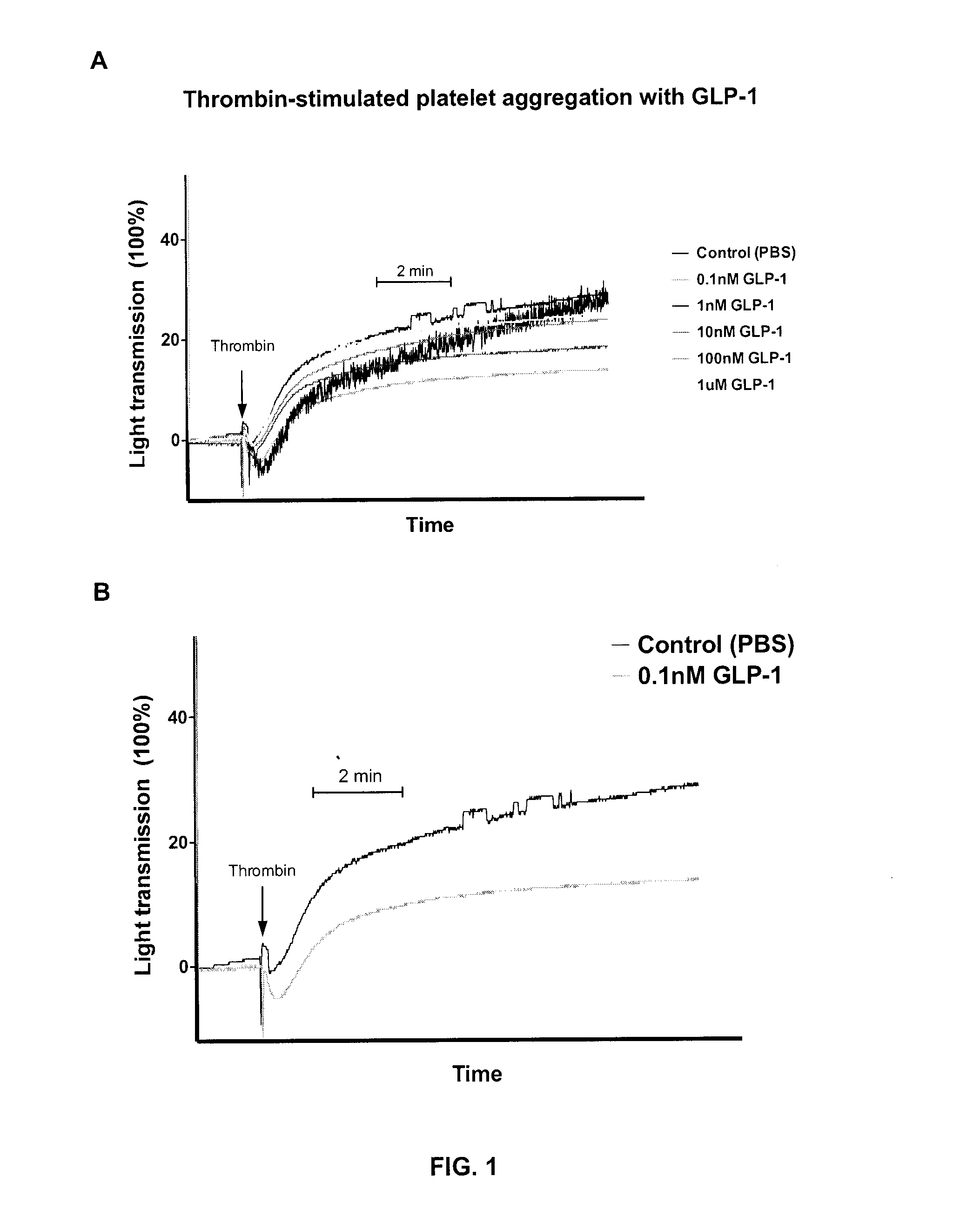Methods for inhibiting platelet aggregation using glp-1 receptor agonists
a technology of glp-1 receptor and platelet aggregation, which is applied in the direction of peptide/protein ingredients, extracellular fluid disorder, metabolic disorder, etc., can solve the problem of increasing intracellular camp levels, and achieve the effect of improving the therapeutic or pharmacokinetic properties of peptides
- Summary
- Abstract
- Description
- Claims
- Application Information
AI Technical Summary
Benefits of technology
Problems solved by technology
Method used
Image
Examples
example 1
GLP-1 and GLP-1R Agonists Inhibit Thrombin-Induced Human Platelet Aggregation
Materials and Methods
[0064]Cloning / Sequencing:
[0065]RT-PCR was performed on RNA from MEG-01 cells with primers designed to yield full-length human GLP-1R cDNA. PCR products were cloned and sequenced.
[0066]cAMP Assay:
[0067]An EIA kit (Cayman Chemicals) was employed to measure intracellular cAMP levels. MEG-01 cells were incubated for 15 min with 100 pM to 100 nM GLP-1 or Exendin-4. 3-isobutyl-1-methylxanthine (IBMX) was added to each well at a concentration of 0.5 μM and allowed to incubate for 10 min at 37° C. to inhibit phosphodiesterase activity. As a positive control for cAMP generation in MEG-01 cells, PGI2 was added at a concentration of 0.02 ng / ml to control wells and incubated for 10 min at 37° C. PBS was used as a negative control. After incubation, cells were lysed by adding EDTA to a concentration of 10 mM. Lysed cells were transferred to 1.5 ml eppendorf tubes and boiled for 5 min at 95° C. Sampl...
example 2
Human Megakaryocytes and Platelets do not Exhibit DPP4 Activity
[0075]DPP-IV is an aminopeptidase expressed on many tissues throughout the body as a membrane spanning protein, and is also found in the plasma in a soluble form. DPP-IV acts as an enzyme to cleave peptides that have a proline or an alanine in the penultimate position at the N-terminal. GLP-1 has an alanine in this position, and is therefore a substrate for DPP-IV. Dipeptidyl peptidase-4 (DPP4) activity was assessed in different human cell types using the CBA085 Innozyme™ DPP4 Immunocapture Activity Assay. As shown in FIG. 10A, human platelets and megakaryocytes do not appear to exhibit any DPP4 activity. Aggregation assays were carried out using gel-filtered platelets such that there was not expected to be any soluble DPP-IV in the assay. The results of this assay show that MEG-01 cells do not harbor any detectable levels of endogenous DPP-IV activity, and expression on platelets appears to be negligible (FIG. 10B). Hum...
example 3
Exendin-4 Inhibits Thrombus Formation In Vivo
[0076]An in vivo mouse cremaster arteriolar thrombosis model was used to investigate the effects of the GLP-1R agonist exendin-4. Adult mice were anesthetized and a tracheal tube inserted to facilitate breathing. Antibodies and anesthetic reagent (pentobarbital; Abbott Laboratories, Toronto, ON; 0.05 mg / kg) were administered by a jugular vein cannula. The cremaster muscle was prepared under a dissecting microscope and superfused throughout the experiment with preheated bicarbonate-buffered saline. Platelets were labelled by injecting an Alexa 660-conjugated anti-GP1b antibody. Multiple independent upstream injuries were performed on a cremaster arteriole with the use of an Olympus BX51WI microscope with a pulsed nitrogen dye laser. The dynamic accumulation of fluorescently labeled platelets within the growing thrombus was captured and analyzed using Slidebook software (Intelligent Imaging Innovations). Five minutes before injury, mice wer...
PUM
| Property | Measurement | Unit |
|---|---|---|
| concentration | aaaaa | aaaaa |
| platelet aggregation | aaaaa | aaaaa |
| aggregation | aaaaa | aaaaa |
Abstract
Description
Claims
Application Information
 Login to View More
Login to View More - R&D
- Intellectual Property
- Life Sciences
- Materials
- Tech Scout
- Unparalleled Data Quality
- Higher Quality Content
- 60% Fewer Hallucinations
Browse by: Latest US Patents, China's latest patents, Technical Efficacy Thesaurus, Application Domain, Technology Topic, Popular Technical Reports.
© 2025 PatSnap. All rights reserved.Legal|Privacy policy|Modern Slavery Act Transparency Statement|Sitemap|About US| Contact US: help@patsnap.com



